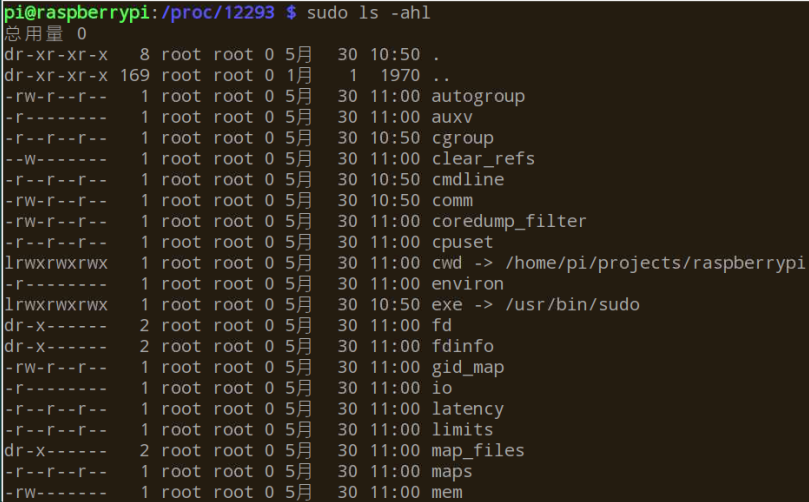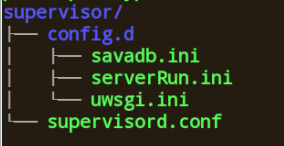查看进程
ps aux | grep python 或者 ps -ef | grep python
可以通过查看 /proc/PID/ 目录的文件信息来得到这个进程的一些信息(Linux中一切皆文件,进程信息也在文件中)cd /proc/12293(12293是进程的id号)sudo ls -ahl
该进程的详细信息显示如下:
杀死进程
kill PID或者kill -9 PID(强制杀死进程)kill -l查看kill命令的所有信号。
kill -9 PID 和 kill -SIGKILL PID命令等价,强制杀死一个进程。
信号SIGHUP通常程序用这个信号进行优雅重载配置文件,重新启动并且不影响正在运行的服务。比如kill -1 uwsgi 优雅重启uwsgi 进程,对服务器没有影响kill -1 NGINX_PID 优雅重启nginx进程,对服务器没有影响CTRL-C发送 SIGINT 信号给前台进程组中的所有进程,常用于终止正在运行的程序。CTRL-Z发送 SIGTSTP 信号给前台进程组中的所有进程,常用于挂起一个进程。
查看进程当前状态
端口分析
sudo netstat -nltp可以查看服务器中监控了哪些端口,netstat选项如下。-a或—all 显示所有连接中的Socket,默认不显示 LISTEN 相关的。
-c或—continuous 持续列出网络状态,不断自动刷新输出。
-l或—listening 显示监听中的服务器的Socket。
-n或—numeric 直接使用IP地址,而不是展示域名。
-p或—programs 显示正在使用Socket的程序进程PID和名称。
-t或—tcp 显示TCP传输协议的连接。
-u或—udp 显示UDP传输协议的连接。
进程管理软件supervisor
安装
1 pip安装:pip install supervisor
2 源码安装:下载源文件压缩包.tar.gz,解压缩,进入setup.py目录,运行命令python setup.py install
配置
cd /home/pi/supervisor/echo_supervisord_conf > supervisord.conf
以上命令将默认配置重定向到/home/pi/supervisor/supervisord.conf
配置文件说明
; Sample supervisor config file.;; For more information on the config file, please see:; http://supervisord.org/configuration.html;; Notes:; - Shell expansion ("~" or "$HOME") is not supported. Environment; variables can be expanded using this syntax: "%(ENV_HOME)s".; - Quotes around values are not supported, except in the case of; the environment= options as shown below.; - Comments must have a leading space: "a=b ;comment" not "a=b;comment".; - Command will be truncated if it looks like a config file comment, e.g.; "command=bash -c 'foo ; bar'" will truncate to "command=bash -c 'foo ".[unix_http_server]file=/var/run/supervisor.sock ; the path to the socket file;chmod=0700 ; socket file mode (default 0700);chown=nobody:nogroup ; socket file uid:gid owner;username=user ; default is no username (open server);password=123 ; default is no password (open server)[inet_http_server] ; inet (TCP) server disabled by default(网页端访问配置)port=127.0.0.1:9001 ; ip_address:port specifier, *:port for all ifaceusername=user ; default is no username (open server)password=123 ; default is no password (open server)[supervisord]logfile=/var/run/supervisord.log ; main log file; default $CWD/supervisord.loglogfile_maxbytes=50MB ; max main logfile bytes b4 rotation; default 50MBlogfile_backups=10 ; # of main logfile backups; 0 means none, default 10loglevel=info ; log level; default info; others: debug,warn,tracepidfile=/var/run/supervisord.pid ; supervisord pidfile; default supervisord.pidnodaemon=false ; start in foreground if true; default falseminfds=1024 ; min. avail startup file descriptors; default 1024minprocs=200 ; min. avail process descriptors;default 200;umask=022 ; process file creation umask; default 022;user=supervisord ; setuid to this UNIX account at startup; recommended if root;identifier=supervisor ; supervisord identifier, default is 'supervisor';directory=/tmp ; default is not to cd during start;nocleanup=true ; don't clean up tempfiles at start; default false;childlogdir=/tmp ; 'AUTO' child log dir, default $TEMP;environment=KEY="value" ; key value pairs to add to environment;strip_ansi=false ; strip ansi escape codes in logs; def. false; The rpcinterface:supervisor section must remain in the config file for; RPC (supervisorctl/web interface) to work. Additional interfaces may be; added by defining them in separate [rpcinterface:x] sections.[rpcinterface:supervisor]supervisor.rpcinterface_factory = supervisor.rpcinterface:make_main_rpcinterface; The supervisorctl section configures how supervisorctl will connect to; supervisord. configure it match the settings in either the unix_http_server; or inet_http_server section.[supervisorctl]serverurl=unix:///var/run/supervisor.sock ; use a unix:// URL for a unix socketserverurl=http://127.0.0.1:9001 ; use an http:// url to specify an inet socketusername=user ; should be same as in [*_http_server] if setpassword=123 ; should be same as in [*_http_server] if set;prompt=mysupervisor ; cmd line prompt (default "supervisor");history_file=~/.sc_history ; use readline history if available; The sample program section below shows all possible program subsection values.; Create one or more 'real' program: sections to be able to control them under; supervisor.;[program:theprogramname];command=/bin/cat ; the program (relative uses PATH, can take args);process_name=%(program_name)s ; process_name expr (default %(program_name)s);numprocs=1 ; number of processes copies to start (def 1);directory=/tmp ; directory to cwd to before exec (def no cwd);umask=022 ; umask for process (default None);priority=999 ; the relative start priority (default 999);autostart=true ; start at supervisord start (default: true);startsecs=1 ; # of secs prog must stay up to be running (def. 1);startretries=3 ; max # of serial start failures when starting (default 3);autorestart=unexpected ; when to restart if exited after running (def: unexpected);exitcodes=0 ; 'expected' exit codes used with autorestart (default 0);stopsignal=QUIT ; signal used to kill process (default TERM);stopwaitsecs=10 ; max num secs to wait b4 SIGKILL (default 10);stopasgroup=false ; send stop signal to the UNIX process group (default false);killasgroup=false ; SIGKILL the UNIX process group (def false);user=chrism ; setuid to this UNIX account to run the program;redirect_stderr=true ; redirect proc stderr to stdout (default false);stdout_logfile=/a/path ; stdout log path, NONE for none; default AUTO;stdout_logfile_maxbytes=1MB ; max # logfile bytes b4 rotation (default 50MB);stdout_logfile_backups=10 ; # of stdout logfile backups (0 means none, default 10);stdout_capture_maxbytes=1MB ; number of bytes in 'capturemode' (default 0);stdout_events_enabled=false ; emit events on stdout writes (default false);stdout_syslog=false ; send stdout to syslog with process name (default false);stderr_logfile=/a/path ; stderr log path, NONE for none; default AUTO;stderr_logfile_maxbytes=1MB ; max # logfile bytes b4 rotation (default 50MB);stderr_logfile_backups=10 ; # of stderr logfile backups (0 means none, default 10);stderr_capture_maxbytes=1MB ; number of bytes in 'capturemode' (default 0);stderr_events_enabled=false ; emit events on stderr writes (default false);stderr_syslog=false ; send stderr to syslog with process name (default false);environment=A="1",B="2" ; process environment additions (def no adds);serverurl=AUTO ; override serverurl computation (childutils); The sample eventlistener section below shows all possible eventlistener; subsection values. Create one or more 'real' eventlistener: sections to be; able to handle event notifications sent by supervisord.;[eventlistener:theeventlistenername];command=/bin/eventlistener ; the program (relative uses PATH, can take args);process_name=%(program_name)s ; process_name expr (default %(program_name)s);numprocs=1 ; number of processes copies to start (def 1);events=EVENT ; event notif. types to subscribe to (req'd);buffer_size=10 ; event buffer queue size (default 10);directory=/tmp ; directory to cwd to before exec (def no cwd);umask=022 ; umask for process (default None);priority=-1 ; the relative start priority (default -1);autostart=true ; start at supervisord start (default: true);startsecs=1 ; # of secs prog must stay up to be running (def. 1);startretries=3 ; max # of serial start failures when starting (default 3);autorestart=unexpected ; autorestart if exited after running (def: unexpected);exitcodes=0 ; 'expected' exit codes used with autorestart (default 0);stopsignal=QUIT ; signal used to kill process (default TERM);stopwaitsecs=10 ; max num secs to wait b4 SIGKILL (default 10);stopasgroup=false ; send stop signal to the UNIX process group (default false);killasgroup=false ; SIGKILL the UNIX process group (def false);user=chrism ; setuid to this UNIX account to run the program;redirect_stderr=false ; redirect_stderr=true is not allowed for eventlisteners;stdout_logfile=/a/path ; stdout log path, NONE for none; default AUTO;stdout_logfile_maxbytes=1MB ; max # logfile bytes b4 rotation (default 50MB);stdout_logfile_backups=10 ; # of stdout logfile backups (0 means none, default 10);stdout_events_enabled=false ; emit events on stdout writes (default false);stdout_syslog=false ; send stdout to syslog with process name (default false);stderr_logfile=/a/path ; stderr log path, NONE for none; default AUTO;stderr_logfile_maxbytes=1MB ; max # logfile bytes b4 rotation (default 50MB);stderr_logfile_backups=10 ; # of stderr logfile backups (0 means none, default 10);stderr_events_enabled=false ; emit events on stderr writes (default false);stderr_syslog=false ; send stderr to syslog with process name (default false);environment=A="1",B="2" ; process environment additions;serverurl=AUTO ; override serverurl computation (childutils); The sample group section below shows all possible group values. Create one; or more 'real' group: sections to create "heterogeneous" process groups.;[group:thegroupname];programs=progname1,progname2 ; each refers to 'x' in [program:x] definitions;priority=999 ; the relative start priority (default 999); The [include] section can just contain the "files" setting. This; setting can list multiple files (separated by whitespace or; newlines). It can also contain wildcards. The filenames are; interpreted as relative to this file. Included files *cannot*; include files themselves.[include]files = /home/pi/supervisor/config.d/*.ini
[program:theprogramname]进程配置可以直接在supervisord.conf文件中书写,但是不建议,应该把程序配置单独写到.ini文件中,然后放到/home/pi/supervisor/config.d/目录中,目录文件关系如下所示。
各程序配置文件如下:
uwsgi网络服务器:
[program:uwsgi]
directory=/home/pi/projects/django/monitor/ ;服务文件所在的目录,如果是.py文件,引入自定义的.py模块,指定其文件目录就非常重要
command=/usr/local/bin/uwsgi --emperor /etc/uwsgi/vassals ;启动程序的命令,也就是在控制台输入的命令
autostart=true ;在supervisord启动的时候也自动启动
startsecs=5 ;启动 5 秒后没有异常退出,就当作已经正常启动了
autorestart=true ;程序异常退出后自动重启
startretries=3 ;启动失败自动重试次数
redirect_stderr=true ;把stderr重定向到stdout,默认false
stdout_logfile_maxbytes=1MB ;stdout日志文件大小
stdout_logfile_backups=10 ;stdout日志文件备份数
stdout_logfile=/home/pi/projects/django/monitor/supervisor_uwsgi.log ;stdout日志文件,需要注意当指定目录不存在时无法正常启动,所以需要手动创建目录(supervisord 会自动创建日志文件)
loglevel=info ;日志级别
python脚本:serverRun.py和savedb.py
[program:serverRun]
directory=/home/pi/projects/raspberrypi/ ;如果在severRun.py代码中引入了模块Operations.py,这就需要指定py文件的目录/home/pi/projects/raspberrypi/
command=python /home/pi/projects/raspberrypi/serverRun.py
autostart=true
startsecs=5
autorestart=true
startretries=3
redirect_stderr=true
stdout_logfile_maxbytes=1MB
stdout_logfile_backups=10
stdout_logfile=/home/pi/projects/raspberrypi/supervisor_serverRun.log
loglevel=info
[program:savedb]
directory=/home/pi/projects/raspberrypi/
command=python /home/pi/projects/raspberrypi/savedb.py
autostart=true
startsecs=5
autorestart=true
startretries=3
redirect_stderr=true
stdout_logfile_maxbytes=1MB
stdout_logfile_backups=10
stdout_logfile=/home/pi/projects/raspberrypi/supervisor_savedb.log
loglevel=info
启动
进入supervisord.conf配置文件目录,输入如下命令启动:supervisord -c supervisord.conf
使用supervisorctl监控
运行命令:supervisorctl 或者 supervisorctl -c supervisord.conf
进入supervisorctl的shell界面,在shell界面可以使用如下命令:
help #查看所有命令
help reread #查看reread命令帮助文档
status # 查看程序状态
stop procName #关闭procName程序
start procName #启动procName程序
restart procName #重启procName程序
reread #读取有更新(增加)的配置文件,不会启动新添加的程序
update #重启配置文件修改过的程序
也可以直接在linux终端使用supervisorctl命令监控进程:
supervisorctl status
supervisorctl stop procName
supervisorctl start procName
supervisorctl restart procName
supervisorctl reread
supervisorctl update
在web端监控
supervisord.conf配置文件有如下内容,配置了网页端访问的端口和账户密码。
[inet_http_server] ; inet (TCP) server disabled by default(网页端访问配置)
port=127.0.0.1:9001 ; ip_address:port specifier, *:port for all iface
username=user ; default is no username (open server)
password=123 ; default is no password (open server)
打开浏览器,输入127.0.0.1:9001,打开监控界面如下图所示:

管理进程组
待开发
开机自启动
配置systemctl服务
创建supervisor.service文件:sudo vim /lib/systemd/system/supervisor.service
[Unit]
Description=supervisor
After=network.target
[Service]
Type=forking
ExecStart=/usr/local/bin/supervisord -c /home/pi/supervisor/supervisord.conf
ExecStop=/usr/local/bin/supervisorctl shutdown
ExecReload=/usr/local/bin/supervisorctl reload
KillMode=process
Restart=on-failure
RestartSec=42s
[Install]
WantedBy=multi-user.target
设置开机启动:systemctl enable supervisor.servicesystemctl daemon-reload
修改文件权限:chmod 766 supervisor.service
配置service类型服务
sudo vim /etc/rc.d/init.d/supervisor
#!/bin/bash
#
# supervisord This scripts turns supervisord on
#
# Author: Mike McGrath <mmcgrath@redhat.com> (based off yumupdatesd)
#
# chkconfig: - 95 04
#
# description: supervisor is a process control utility. It has a web based
# xmlrpc interface as well as a few other nifty features.
# processname: supervisord
# config: /home/pi/supervisor/supervisord.conf
# pidfile: /var/run/supervisord.pid
#
# source function library
. /etc/rc.d/init.d/functions
RETVAL=0
start() {
echo -n $"Starting supervisord: "
daemon "supervisord -c /home/pi/supervisor/supervisord.conf "
RETVAL=$?
echo
[ $RETVAL -eq 0 ] && touch /var/lock/subsys/supervisord
}
stop() {
echo -n $"Stopping supervisord: "
killproc supervisord
echo
[ $RETVAL -eq 0 ] && rm -f /var/lock/subsys/supervisord
}
restart() {
stop
start
}
case "$1" in
start)
start
;;
stop)
stop
;;
restart|force-reload|reload)
restart
;;
condrestart)
[ -f /var/lock/subsys/supervisord ] && restart
;;
status)
status supervisord
RETVAL=$?
;;
*)
echo $"Usage: $0 {start|stop|status|restart|reload|force-reload|condrestart}"
exit 1
esac
exit $RETVAL
修改文件权限,设置开机自启动chmod 755 /etc/rc.d/init.d/supervisorchkconfig supervisor on
其它Linux发行版开机启动脚本:https://github.com/Supervisor/initscripts
rc.local脚本
Linux 在启动的时候会执行 /etc/rc.local 里面的脚本,所以只要在rc.local文件添加执行命令就可以。
sudo /usr/local/bin/supervisord -c /home/pi/supervisor/supervisord.conf
以上内容需要添加在 exit 0命令前。而且由于在执行 rc.local 脚本时,PATH 环境变量未全部初始化,因此命令需要使用绝对路径。
注意事项
1、supervisor的日志文件.log只能是英文编码,不能打印中文。所以程序里有打印中文日志的代码运行会出错。
2、supervisord.pid 以及 supervisor.sock 是放在 /tmp 目录下,但是 /tmp 目录是存放临时文件,里面的文件是会被 Linux 系统删除的,所以建议把.pid或者.sock文件放在/var/run/目录下。
3、supervisord管理的进程必须由supervisord来启动,supervisord还要求管理的程序是非daemon程序,supervisord会帮你把它转成daemon程序,因此如果用supervisord来管理nginx的话,必须在nginx的配置文件里添加一行设置daemon off让nginx以非daemon方式启动。
参考文档
http://supervisord.org/index.html
https://www.jianshu.com/p/bf2b3f4dec73
https://www.cnblogs.com/xingzc/p/6612270.html
https://serverfault.com/questions/96499/how-to-automatically-start-supervisord-on-linux-ubuntu
https://www.jb51.net/article/142427.htm
其他进程管理软件
Monit,launchd, daemontools, and runit.

